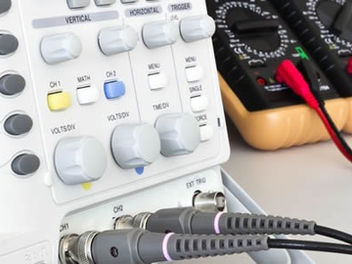What is PAT Testing & Why is it Required?
- Guy hudson
- Jul 20, 2023
- 4 min read
In today's electrifying world of gadgets and gizmos, keeping the sparks of electrical safety alive is an absolute must! And here comes our superhero, Portable Appliance Testing (PAT testing), to save the day! Just like a fashion makeover for your favourite electrical equipment, PAT testing is a process that inspects and tests those trusty gadgets to ensure they're both safe and following the rules set by regulatory wizards.
So, buckle up your electrical seatbelts and join us on this electrifying adventure through the world of PAT testing! We'll uncover the secrets of this superhero process, making sure your beloved electrical equipment gets the stamp of approval - the legendary "Pat tested" badge. Get ready to power up and embark on this fun journey into the world of electrical safety, one plug at a time!

Understanding PAT Testing: Ensuring Electrical Safety
PAT testing is a systematic approach used to examine and assess electrical appliances, ensuring they are safe for use. The primary objective is to identify any potential electrical hazards or faults that could lead to accidents, electrical shocks, or fire outbreaks. This testing procedure is commonly carried out in workplaces, commercial establishments, schools, hospitals, and even homes, where electrical appliances are widely used.
During the PAT testing process, a qualified electrician, also known as a PAT tester, conducts a series of tests on electrical appliances to determine their safety. The process typically includes a visual inspection, followed by various electrical tests using specialised PAT testing equipment.
7 Reasons to Understand the Purpose of PAT Testing
Ensuring Electrical Safety: The foremost reason for PAT testing is to ensure the safety of individuals using electrical appliances. Electrical equipment, including portable appliances, can pose potential risks if not properly maintained.
Mitigating Potential Hazards: PAT testing helps identify potential electrical hazards that may not be apparent during visual inspections alone. Portable appliances are susceptible to wear and tear, and defects can develop over time.
Preventing Electrical Accidents: Detecting faulty appliances is crucial for preventing electrical accidents. Appliances that are not functioning correctly or have damaged components can lead to electric shocks, fires, or other hazardous situations.
Identifying Faulty Appliances: PAT testing involves a series of tests to assess the condition of electrical appliances. These tests help identify appliances that may pose a safety risk due to defects or damage.
Complying with Legal Regulations: In many countries, including the UK, PAT testing is a legal requirement for landlords and businesses. Regulatory authorities and insurance companies often mandate regular PAT testing to ensure compliance with safety standards. Failure to comply with these regulations can result in legal penalties, financial liabilities, and potential difficulties with insurance claims.
Promoting a Safe Working Environment: For businesses and organisations, PAT testing is essential for promoting a safe working environment. Employees and customers should feel confident that the electrical equipment used within the premises is safe and well-maintained.
Meeting Insurance Requirements: PAT testing is often a prerequisite for obtaining insurance coverage for businesses. Insurance companies may require evidence of regular PAT testing to assess the level of risk associated with a property or business.
Investing in PAT testing is not just a legal obligation; it is a proactive measure to safeguard lives and property. Regular PAT testing ensures electrical safety, identifies potential hazards, and fosters a secure environment for everyone.
7 Benefits of Ensuring Electrical Safety through PAT Testing
Prevention of Electrical Accidents: Regular PAT testing significantly reduces the risk of electrical accidents, protecting individuals and property. By identifying potential hazards and faulty appliances, PAT testing allows for timely corrective actions, preventing accidents such as electric shocks and fires.
Identification of Faulty Appliances: PAT testing helps identify faulty appliances early on, allowing for timely repairs or replacements. Defective components or wear and tear can lead to hazardous situations, but with PAT testing, these issues are detected and addressed before they escalate.
Compliance with Legal and Regulatory Requirements: PAT testing is not just a best practice; it is a legal obligation for landlords and businesses. Compliance with safety regulations and conducting regular PAT tests ensure that you meet your legal requirements, avoiding potential legal issues and penalties.
Maintenance of a Safe Working Environment: For businesses, ensuring a safe working environment is paramount. Employees can work confidently knowing that the electrical equipment they use is regularly tested for safety. A safe environment fosters productivity and employee well-being.
Reduction of Risk to Employees and Customers: PAT testing minimizes the risk of electrical hazards to both employees and customers. Whether in an office, retail space, or rental property, ensuring the safety of portable appliances protects everyone on the premises.
Preservation of Business Reputation: Demonstrating a commitment to electrical safety enhances a business's reputation and instils trust in customers. Safety-conscious businesses are more likely to attract and retain clients, who prioritise their well-being.
Peace of Mind Knowing Electrical Safety is Prioritised: For landlords and property owners, knowing that electrical safety is a top priority provides peace of mind. Regular PAT testing ensures that portable appliances are safe for use, reducing the risk of accidents and potential liabilities.
The Different Types of PAT Tests Conducted
Visual Inspection
Earth Continuity Test
Insulation Resistance Test
Earth Leakage Test
Load and Polarity Test
Functional Test
Conclusion
Electrical safety is not something to be taken lightly, especially when it concerns the well-being of individuals and the security of property. PAT testing plays a crucial role in maintaining electrical safety by identifying potential hazards and ensuring compliance with safety standards.
At Global Compliance UK, we are committed to ensuring electrical safety through professional PAT testing services. Our experienced PAT testers use cutting-edge testing equipment to thoroughly inspect and assess electrical appliances. By investing in our PAT testing services, you can protect your property, reduce risks, and prioritise the safety of your occupants.
Global Compliance UK is a trusted name in the industry, with over 25 years of experience in the Electrical Testing & Inspection field. Covering the entire South of England & South Wales, we also support clients with Nationwide requirements. Our comprehensive range of Electrical Testing & Safety services, including Portable Appliance Testing (PAT Testing), Emergency Light Testing, Fire Alarm Servicing, Energy Performance Certificates (EPC), and more, ensures that you meet all regulations and maintain the highest standards of electrical safety. With competitive pricing for each service offered, you can rely on us for top-notch electrical safety solutions. Visit our website at www.global-compliance.co.uk to learn more and take the first step towards a safer tomorrow.



























Comments